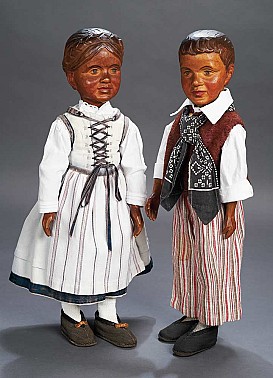The Sister English Poured Wax Doll in Aqua Silk Gown
Lot #103
16" (41 cm.) Poured wax shoulder head,blue glass enamel inset eyes,painted features,light
brown insert hair wig,closed mouth with gentle smile,softly stuffed muslin body,poured wax
lower limbs,bare feet. Condition: generally excellent. Comments: English,in the Montanari
manner,circa 1876,a sister doll to #102,the doll's provenance is described above. Value
Points: beautiful gentle-featured doll with brilliant blue eyes is wearing her original aqua silk
gown under sheer muslin,layered undergarments,kid slippers hand-stitched bonnet with rose
silk ribbons,and carrying an early woven-bead sewing basket. The Story of the Wax Sisters
Dolls is a Curious and Delightful Serendipity: About 1875,a doting English grandfather had
chosen five wax dolls,all identical except the color and small details of their gown,to gift to
his five granddaughters. Time passed,the girls grew up,the dolls passed down in their own
families,generation after generation,and eventually all became separated. Angela Prader
acquired the doll in rose gown,knowing nothing of her story,and displayed her in the
Museum. One day a visitor arrived to tour the Museum and,upon reaching the wax doll in
rose,exclaimed "I have the same doll,but in a different color of gown". Querying the visitor on
her family history and learning of the generous great-great-great grandfather's gifts,it
became obvious that these dolls were two of the five original sister dolls. The doll in aqua silk
soon joined her sister at the Museum,and,just as happily,the two far-flung real-people
relatives,who had never known of the other's existence,became acquainted and re-united the
actual family. The only question remains "where are the remaining three dolls?"
































































































































































































































































































































































































































































































